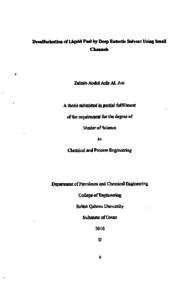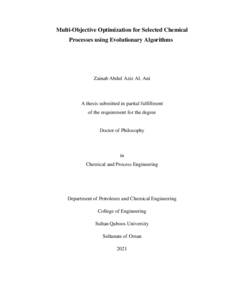وثيقة
Desulfurization of liquid fuel by deep eutectic solvent using small channels.
الناشر
Sultan Qaboos University
ميلادي
2016
اللغة
الأنجليزية
الموضوع
الملخص الإنجليزي
The various sulfuric compounds, which are found in different fuel types, have acute negative influence on the ecosystem and human beings in general. They can also deactivate catalysts and increase corrosion in process equipment. Due to these negative impacts, production of ultra-low sulfur content fuel in many parts of the world became an increasingly rigorous regulation. Many techniques are used for desulfurization; one of them is extractive desulfurization (EDS). This technique has high extraction efficiencies towards thiophenic compounds, can be applied at ambient operating conditions and without consumption of hydrogen. These advantages make EDS a much cheaper option compared to other techniques. Deep eutectic solvents (DESs) can be used in EDS, as they are efficient, biodegradable, which makes it an environmentally friendly process, and they are highly chemically and thermally stable. DESs are normally expensive; however, the high cost of these types of solvents can be overcome by using micro/small channels and regenerating the solvent. The work presented in this thesis aims to investigate experimentally using DES as liquid fuel deep desulfurization solvents for continuous liquid-liquid microchannels-based extraction contactors. The aim is to enhance the sulfur removal and reduce the cost of using these fluids for practical applications. The investigation was carried out in a circular 1.22 mm ID glass small channel. The working fluids were simulated fuel with 200 ppm dibenzothiophene (DBT) and DES of tetra-n-butylammonium bromide (TBAB) and polyethylene glycol 200 with a molar ratio of 1:2 respectively. The DES density and viscosity are 1094 kg/m* and 0.2 Pa.s respectively, while those of simulated fuel are 739.4 kg/m and 8x10-4 Pa.s respectively. The range of mixture velocity which was covered by the study varied from 0.033 to 0.5 m/s for different DES volume fractions. The effect of the inlet junction and initial channel saturation phase on the flow patterns and pressure drop was examined using Canon EOS 1100D camera and a digital monometer, respectively. Seven flow patterns were observed. These are stratified wavy, annular, intermittent, slug, plug, drop and dispersed flows. The pressure drop across the glass channel was found to increase gradually with increasing the DES velocity. Also, it was found that the pressure drop and flow patterns were not much affected by changing the saturation fluid. The influence of initial dibenzothiophene (DBT) concentration, mixture velocity, DES volume fractions and channel lengths on the extraction percentage (E%) was studied. Initial DBT concentration did not have an effect on E%, while increasing the length of the channel and the volume fraction of the DES caused an increase in E%. The highest E% was achieved at a DES volume fraction of 0.5, 50 cm channel length and a mixture velocity of 0.2 m/s, which was 47%. This result shows that small channels have potential in DBT extraction using DES. The overall mass transfer coefficient also determined. In addition, a correlation for each channel length was derived for predicting E%.
المجموعة
URL المصدر
الملخص العربي
مركبات الكبريت المتعددة التي تتواجد في مختلف أنواع الوقود, لها تأثير سلبي كبير على البيئة و الإنسان بشكل عام. فهذه المركبات لديها القدرة على تقليل فعالية العوامل المحفزة و الذي يؤدي بدوره إلى التسبب في حدوث صدا في الأجهزة المستخدمة في الصناعة. و نظرا لهذه الأثار السلبية الي تسببها هذه المركبات؛ فإن إنتاج وقود بمحتوی كبريتي منخفض جدا أصبح مطلبا متزايدا في العديد من دول العالم. هناك العديد من التقنيات المستخدمة في إزالة هذه المركبات والاستخلاص يعتبر إحداها, حيث تمتلك هذه التقنية فعالية كبيرة في إزالة مركبات الكبريت الثايوفينية و من الممكن تطبيقها في درجات حرارة وضغط طبيعيين بدون أي استهلاك للهيدروجين وهو ما يجعل هذه التقنية خيارا أقل تكلفة مقارنة بغيرها. المذيبات اليوتكتيكية يمكن استخدامها في الإستخلاص بسبب فاعليتها, قابليتها للتحلل - وهو ما يجعلها خيارا صديقا للبيئة. و أيضا استقرارها الكيميائي و الحراري. استخدام القنوات الدقيقة أو الصغيرة وتجديد المذيب الذي سبق استخدامه يساعدان في تجاوز عقبة ارتفاع أسعار هذه المنيبات المنيب المستخدم في الدراسة يتكون من رباعي بيوتيل بروميد الأمونيوم و بولي إيثلين جلايكول 200 بنسبة مولية 2 : 1 على التوالي. تم دراسة العديد من الأهداف، و هي: أشكال الجريان و انخفاض الضغط في قناة زجاجية ذات قطر يبلغ mm 1 . 22 للسوائل المستخدمة (المنيب البوتكتيكي و الوقود المحاکی), تأثير شكل تقاطع التقاء السائلين و السائل الذي تتشبع به القناة في البداية على شكل الجريان و انخفاض الضغط, تأثير التركيز الأولي للدايبنزو ثايوفين على نسبة إزالته (%E) بالاستخلاص, تأثير سرعة المزيج النسبة الحجمية للمذيب في المزيج و طول القناة على %E. مدى سرعة المزيج الذي تم دراسته هو 0 . 33 - 0 . 5 m / s وجد أن انخفاض الضغط و شكل الجريان لم يتأثرا بشكل كبير بتغيير سائل تشبع القناة الأولي الأشكال الأساسية اللجريان التي تم ملاحظتها هي: حلقي, انغماس الوقود المحاكي في المنيب, و قطرات من الوقود في المذيب انخفاض الضغط على طول القناة البالغ cmm 10 ازداد بازدیاد سرعة المذيب. التركيز الأولى للدايبنزو تایوفين لم يكن له أي تأثير على %E, بينما زيادة طول القناة و نسية المذيب في المزيج أدى إلى زيادة %E. أعلى نتيجة ل %E تم الوصول إليها باستخدام 50% من المذيب في المزيج في قناة بلغ طولها cm 50 و بسرعة كلية بلغت 0 . 2 m / s , و التي بلغت %47. هذه النتيجة أظهرت أن القنوات الصغيرة لديها إمكانيات في استخدامها لاستخلاص الدايبنزو ثايوفين باستخدام المذيبات اليوتكتيكية. ثابت انتقال الكتلة الحجمي تم إيجاده لكل الحالات التي تم دراستها. إضافة الى ذلك, تم إيجاد معادلة لحساب %E, لمختلف الأطوال المستخدمة.
قالب العنصر
الرسائل والأطروحات الجامعية








